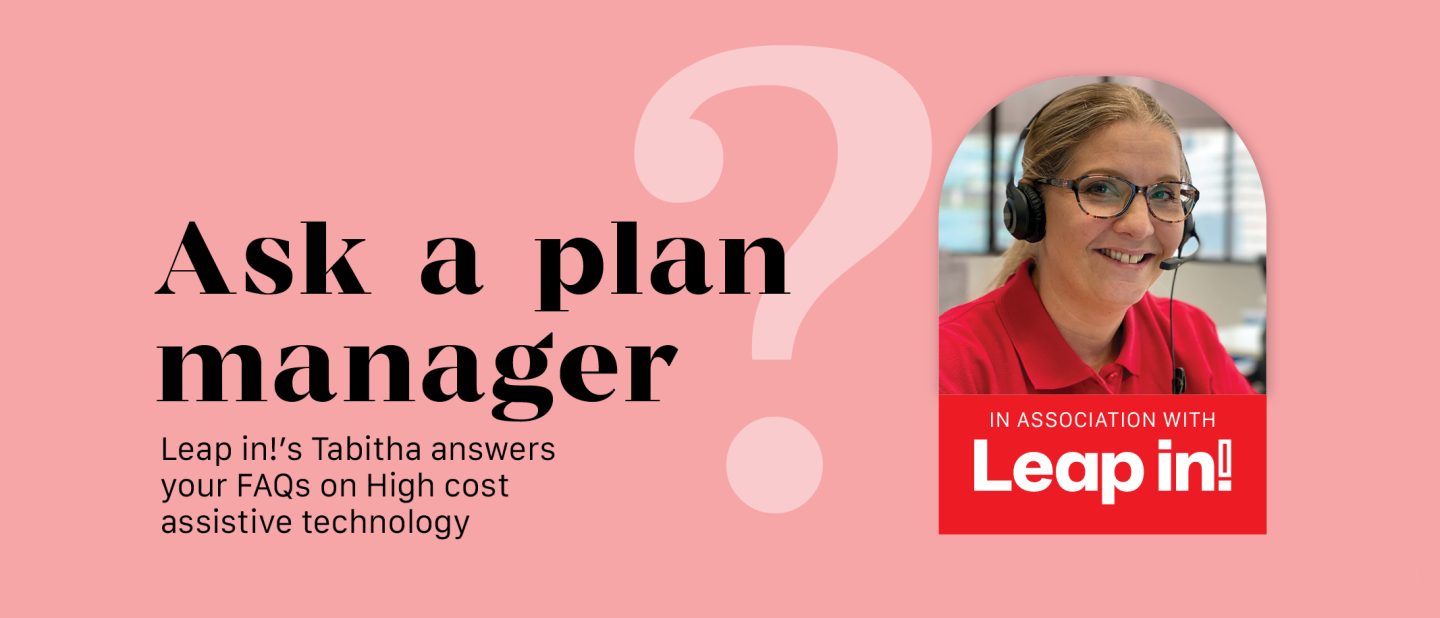
Ask a Plan Manager: High cost assistive technology
Sponsored content
Purchasing assistive technology (AT) for your child or young adult can be a little daunting, especially when it’s a significant investment. You want to be confident the item is right for their needs and, of course, good value for money. Experienced Leap in! plan manager Tabitha is on hand to help.
Tabitha answers some frequently asked questions about high cost AT including communication devices so you know what to expect if you’re exploring options for someone in your family or care.
What high cost assistive technology may be suitable for purchase under an NDIS Plan?
High cost assistive technology under the NDIS is any item of AT that costs more than $15,000. By its very nature, high cost AT tends to be complex. It’s sometimes custom-made or tailored for the individual.
High cost assistive technology includes higher cost augmentative and alternative communication devices (AAC), custom wheelchairs, prosthetics, ventilators and some specialised patient lifts or hoist systems.
How can I get high cost AT included in my child’s NDIS Plan?
An occupational therapist (OT) or physio can talk to you about the kinds of AT that might help your child meet their goals.
If high cost AT is required, a professional AT advisor will need to complete an AT assessment. The NDIS may include funding in your child’s plan for an AT assessment if you don’t already have one.
The assessment looks at how each feature of the AT helps with building skills and independence, and how it relates to other types of support. The NDIS has templates to guide assessors through this process, which are available on the NDIS website under the For Providers section.
The AT assessment is submitted to the NDIS with an itemised quote from one or more providers for the item. If approved, the funds are added to the Capital supports budget in the person’s NDIS Plan.
Does a high cost AT quote need to include the cost of other items, like delivery?
Yes. The quote should cover everything associated with the purchase, including delivery, set up costs, and any customisation required. It should also include the brand name and model number.
Before buying, can I use my child’s NDIS funding to trial assistive technology?
With so many different brands and options for AT, you’ll sometimes want to test an item before buying or renting. Some providers will let you try a product at no cost.
If not, you can use your child’s NDIS funds to pay for a trial. If your child is on a PACE plan, they will need funding under the new Capital supports – Assistive Technology, maintenance, repair and rental budget to trial high cost AT. If they’re on the old style or legacy plan, you may be able to use Core supports flexibly to trial the item.
Details about the outcome of any trials need to be included in the AT assessment.
My daughter has a high cost augmentative and alternative communication (AAC) device approved and included in her NDIS Plan. Do I have to cover the cost upfront?
If your daughter has a plan manager like Leap in! the provider can generally send the invoice to your plan manager to process the payment from your daughter’s plan so you’re not out of pocket.
If your daughter’s plan is Agency managed, the provider needs to be NDIS registered. The usual process applies where the provider submits the claim for payment through the NDIS portal.
If you self manage, there are two options:
• Make a payment request through the NDIS. Money from your daughter’s NDIS Plan budget will be paid into your account. You can then pay the provider.
• You can pay for the item upfront, then submit a claim to the NDIS for reimbursement.
What about mid cost AT? Can you please explain how the new $15,000 limit for AT works?
If you have relevant evidence and the funding in your plan budget, the NDIS will automatically approve purchases of mid cost AT valued between $1,500 and $15,000. No quote is required. However, you need to submit written evidence for items costing more than $1,500. This can be done by obtaining a letter or report from an AT advisor outlining the item, how it will assist and why it is the best value for money.
Does “higher risk” AT refer to items that cost more?
Good question! The NDIS has two “product” risk categories for assistive technology: low risk and higher risk. While higher risk technology is often more expensive, this is not always the case.
Higher risk items are generally more complex and often require personalised setup. For this reason, advice from an AT advisor or assessor is necessary before purchase, regardless of the cost. The NDIS will not fund some high risk items such as trampolines or swings.
What should I do with high cost AT funded by the NDIS that is no longer needed?
If you have purchased the equipment, you can take it to a service in the community that accepts and refurbishes used equipment or donate it to charity.
If it is under a lease agreement, you need to return it to the provider. Depending on the item, you may also be able to sell it privately.
Did you know you can ask for AT at any time?
That’s right! You don’t need to wait for a plan reassessment. As your child or teen’s goals and needs are constantly changing, there is in-built flexibility in the NDIS for AT requests.
If your child or teen’s needs have changed, you can contact the NDIS at any time. For low or mid cost AT needs, the NDIS may choose to increase the funding of supports in a plan without needing a full reassessment. This is called a plan variation.
It’s worth noting that while an AT request can be submitted at any time during your child’s plan, your request may initiate a plan reassessment by the NDIS.
DO YOU HAVE A QUESTION YOU’D LIKE US TO ANSWER IN THE NEXT EDITION OF SOURCE KIDS? WE’D LOVE TO HEAR FROM YOU. SEND YOUR QUESTION TO [email protected]
Call Leap in! on 1300 05 78 78 or email [email protected] to speak with a team member experienced in the NDIS and assistive technology.







